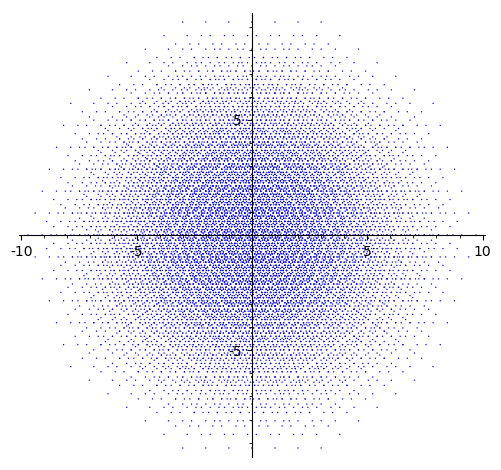For an integer $n \ge 3$, consider the function $$u(n) = \frac{\sigma(n)}{n \log \log n}$$ with $\sigma$ the divisor function. Now consider the sequence (bounded below and decreasing) $$v_n = \sup_{m>n} u(m).$$
Then Robin's theorem states that the Riemann hypothesis (RH) is true if and only if the sequence $(v_n)$ reaches its limit (which means the existence of $m \in \mathbb{N}$ such that $v_m = \lim_{n \to \infty} v_n$).
To illustrate the complexity of the ring $\mathbb{Z}[\zeta_r]$ of cyclotomic integers of degree $r$ (with $\zeta_r=e^{2i\pi/r}$), here is the picture of the set $$\{\sum_{i=0}^4 a_i\zeta_5^i \ | \ a_i \in \mathbb{Z}, |a_i| \le 3 \} \subset \mathbb{Z}[\zeta_5].$$

Consider the quotient map $$i: \mathbb{Z}[\zeta_r] \to \mathbb{Z}[\zeta_r]/\sim$$ with $x \sim y$ if and only if there is a unit $u \in \mathbb{Z}[\zeta_r]$ such that $x=uy$. Then consider $$\mathcal{P}_r = i(\mathbb{Z}[\zeta_r] \cap \mathbb{R}),$$ where $\mathbb{Z}[\zeta_r] \cap \mathbb{R}$ is the ring of real cyclotomic integers of degree $r$.
For $x \in \mathcal{P}_r$, and $a \in i^{-1}(\{ x\})$, consider the set of divisors $$D(x)= i(\{ b \in \mathbb{Z}[\zeta_r] \cap \mathbb{R} \ | \ a/b \in \mathbb{Z}[\zeta_r] \cap \mathbb{R} \}).$$
Question 1: Is the set $D(x)$ finite?
As pointed out by Wojowu in comment (before revision), the group of units can be huge, and so without quotient, the set of divisors could be infinite (for example, let $\phi$ be the golden ratio, then $\phi^k, \phi^{-k} \in \mathbb{Z}[\zeta_5]$, and $1 = \phi^k \cdot \phi^{-k}$ for all $k$). Then Question 1 asks whether the quotient is sufficient to make the set finite.
Assume that Question 1 admits a positive answer (otherwise the definition of $D$ or $\mathcal{P}_r$ should be modified). To define a divisor function $\sigma$, we first need to define a natural non-negative representative for each element of $\mathcal{P}_r$, by a map $$\tau: \mathcal{P}_r \to \mathbb{R}_{\ge 0}.$$ For so, first consider the surjective map: $$ s: \mathbb{Z}^{r} \to \mathbb{Z}[\zeta_r]$$ such that $s(n_0,n_1, \dots, n_{r-1}) = \sum_i n_i \zeta_r^i$.
Let $P(\mathbb{Z}^{r})$ be the set of subsets of $\mathbb{Z}^{r}$. Consider the minimizers map $$m: P(\mathbb{Z}^{r}) \to P(\mathbb{Z}^{r})$$ such that $$m(S) = \{ v \in S \ | \ \Vert v \Vert_2 \le \Vert w \Vert_2, \ \forall w \in S \},$$ next consider the lexicographical order on $\mathbb{Z}^{r}$ defined by $$(n_0, n_1, \dots, n_{r-1}) \le (n'_0, n'_1, \dots, n'_{r-1}) \Leftrightarrow $$ $$n_{r-1} < n'_{r-1} \text{ or } (n_{r-1} = n'_{r-1} \text{ and } n_{r-2} < n'_{r-2}) \text{ or } \dots$$ Finally consider the lexicographical first map $l: P(\mathbb{Z}^{r}) \to \mathbb{Z}^{r}$ such that $l(S) = min(S,\le)$.
Now we can defined the teased map $\tau: \mathcal{P}_r \to \mathbb{R}_{\ge 0}$ as follows: $$ \tau(x) = s \circ l \circ m \circ s^{-1} (i^{-1} (\{x \})\cap \mathbb{R}_{\ge 0}).$$
Note that $\tau$ is unital, i.e. for every unit $u \in \mathbb{Z}[\zeta_r] \cap \mathbb{R}$ then $\tau(i(u))=1$.
For $x \in \mathcal{P}_r$, consider the divisor function $$\sigma(x) = \sum_{y \in D(x)} \tau(y),$$ next, for $\tau(x)>e$, consider the function $$u(x) = \frac{\sigma(x)}{\tau(x) \log \log \tau(x)},$$ and finally consider the sequence $$v_n = \sup_{\tau(x)>n} u(x).$$ Question 2: Is $v_n$ finite?
Assume that Question 2 admits a positive answer (otherwise the definition of $u$ should be modified using a more appropriate asymptotic). Then a degree $r$ cyclotomic Riemann hypothesis (CRH$_r$) can be stated as follows:
The decreasing sequence $v_n$ (defined above with $\mathcal{P}_r$) reaches its limit.
Note that for $r=1,2,3,4,6$, (CRH$_r$) is obviously (RH) because then $\mathbb{Z}[\zeta_r] \cap \mathbb{R} = \mathbb{Z} $.
Question 3.1: Is (CRH$_r$) equivalent to (RH) for all $r$?
Question 3.2: Is there $r$ such that (CRH$_r$) is false?
Note that we can get alternative versions of the post replacing $\mathbb{Z}[\zeta_r] $ by any Noetherian subring of the algebraic integers.
